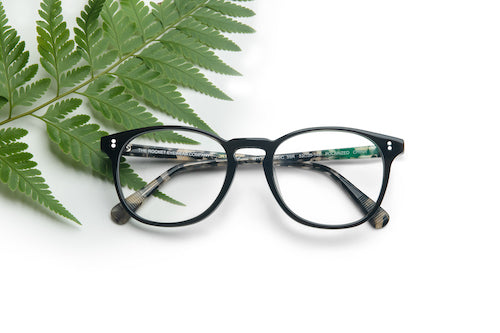What is blue light?

Blue light refers to the high-energy visible (HEV) segment of the visible light spectrum. The visible light spectrum encompasses light with wavelengths from about 400 nm to about 750 nm, whereas blue light ranges from 400 nm to 450 nm, which is the shorter wavelength, higher frequency (energy) portion that digital screens emit.
What are blue-light-blocking glasses?
Blue-light-blocking glasses, also known as screen glasses or computer glasses, filter high-energy visible (HEV) light, the high-frequency segment of the visible light spectrum with wavelengths between 400 nm (nanometers) to 450 nm, preventing it from reaching your eyes.
How do blue-light-blocking lenses work?
Blue-light-blocking filter technology works by either reflecting or absorbing blue light. Lenses with a blue-light-reflecting coating can appear bluish, whereas blue-light-absorbing lenses feature a yellow or amber embedded tint.
Unlike reflective lenses, which can only block around 10% of blue light, most blue-light-absorbing lenses (the ones that look yellow or amber) filter at least 35% of blue light. The more blue light a lens blocks, the more orange it appears. Some lenses block up to 98% of blue light, but they can turn your entire world reddish-brown like a sepia-toned print.

All Rocket Eyewear blue-light-blocking glasses use lightly amber-tinted lenses with minimal color distortion that can filter up 50% of blue light from digital screens (420 to 450 nm).
How do blue-light-blocking lenses protect your eyes?
They can reduce eye strain and improve sleep quality by filtering blue light from digital screens (420 to 450 nm) which can affect our circadian rhythm, suppress melatonin production and disrupt our ability to sleep.
Blue-light-blocking lenses help your biological clock distinguish day from night—especially helpful for those of us who like to use our phones before we sleep.
Do blue-light-blocking glasses actually work?
Consensus appears split between believers who say their blue-light-blocking glasses reduce eye strain and improve sleep quality and disbelievers who question the link between blue light and eye strain.
On one hand, researchers like Dr. Mark Rosenfield of the College of Optometry at State University of New York, who has conducted two studies on the effectiveness of blue light-blocking glasses on digital eye strain, asserts, “the studies actually found that the blue-blocking filters have no effect, no significant effect on digital eye strain. This didn't really come as a major surprise to us because there really is no mechanism whereby the blue light should be causing digital eye strain” (National Public Radio).
On the other hand, in The Journal of Clinical Endocrinology and Metabolism, Steven W Lockley (Associate Professor of Medicine, Harvard University), George C Brainard (Professor of Neurology, Thomas Jefferson University) and Charles A Czeisler (Baldino Professor of Sleep Medicine, Harvard University) published a 2003 study titled “High sensitivity of the human circadian melatonin rhythm to resetting by short wavelength light,” in which they reveal that “460 nm monochromatic light causes twice the amount of melatonin suppression compared to 555 nm monochromatic light, and is dependent on the duration of exposure in addition to wavelength” (National Library of Medicine).
In short, blue light affects our circadian rhythm (our body clock), and blue-light-blocking glasses may improve sleep quality by filtering blue light before it reaches our eyes. Because of the many other factors affecting one's sleep, whether blue-light-blocking glasses actually work remains a matter of personal subjectivity.
